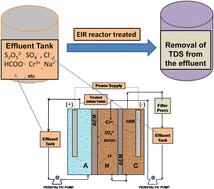当前位置:
X-MOL 学术
›
Environ. Sci.: Water Res. Technol.
›
论文详情
Our official English website, www.x-mol.net, welcomes your feedback! (Note: you will need to create a separate account there.)
Environmentally friendly TDS removal from waste water by electrochemical ion exchange batch-type recirculation (EIR) technique
Environmental Science: Water Research & Technology ( IF 5 ) Pub Date : 2024-01-20 , DOI: 10.1039/d3ew00793f G Vijayakumar 1 , Muniyandi Rajkumar 2 , N Rajiv Chandar 3 , P Selvakumar 4 , Ramesh Duraisamy 5
Environmental Science: Water Research & Technology ( IF 5 ) Pub Date : 2024-01-20 , DOI: 10.1039/d3ew00793f G Vijayakumar 1 , Muniyandi Rajkumar 2 , N Rajiv Chandar 3 , P Selvakumar 4 , Ramesh Duraisamy 5
Affiliation

|
The increasing prevalence of total dissolved solids (TDS), Cl−, SO42−, total suspended solids (TSS), BOD and COD in industrial effluent necessitates pioneering electrochemical approaches for their efficient removal. Synthetic industrial wastewater (SWW) and tannery industrial processing wastewater (TWW) were collected, and studies were performed to explore the synergistic optimization of the current density (CD), anolyte, and cathode compartment effluent volume ratio selection to enhance TDS and other toxic effluent removal efficiencies, where the time did not exceed 8 h. The electrochemical ion exchange batch-type recirculation reactor (EIR) approach was examined with the help of ruthenium oxide-coated titanium (Ru2O/Ti) as the anode and stainless steel (SS) as the cathode, which were separated by a middle compartment. Utilizing a three compartment setup as an electrochemical cell batch-type recirculation design, we investigated the impact of varying the current density on the TDS removal rate and power consumption. In these compartments, we have fixed an anion exchange membrane (AEM-NEOSEPTA) and a cationic exchange resin (CER-AMBERLITE IR 120), where SWW/TWW were allowed to recirculate during the operating time of the reactor. The SWW was treated at various current densities, including 20, 40, 60, 80 and 90 mA cm−2. The maximum removal of Cl− (93%), SO42− (93%), TSS (93%), TDS (93%), BOD5 (93%), and COD (93%) was achieved at a 1 : 2 volume ratio and an optimum low current density of 40 mA cm−2. Our findings reveal an optimal current density range, balancing the removal efficiency and energy consumption of 0.9682 kW h kg−1. These findings indicated that under optimized conditions, the maximum removal efficiencies of Cl−, SO42−, TSS, TDS, BOD5 and COD were 95%, 89%, 89%, 83%, 92% and 89%, respectively from TWW. The optimized system demonstrates superior efficiency in reducing TDS levels, highlighting the significance of parameter tuning in the electrochemical TDS removal process in tannery high saline effluent. This research contributes to the development of sustainable water treatment strategies by presenting a comprehensive approach for enhancing TDS removal through the systematic optimization of key operational parameters. The insights gained from this study will inform the design and implementation of electrochemical systems for TDS-laden effluent treatment, offering a practical pathway toward more efficient and environmentally conscious water remediation practices.
中文翻译:

通过电化学离子交换间歇式再循环 (EIR) 技术从废水中环保地去除 TDS
工业废水中总溶解固体 (TDS)、Cl-、SO42-、总悬浮固体 (TSS)、BOD 和 COD 的含量不断增加,因此需要采用先进的电化学方法来高效去除。收集了合成工业废水 (SWW) 以及制革工业加工废水 (TWW),其研究探索了电流密度 (CD)、阳极电解液和阴极室废水体积比选择的协同优化,以提高 TDS 和其他有毒废水的去除效率,其中时间不超过8h。采用氧化钌涂层钛(Ru2O/Ti)作为阳极,不锈钢(SS)作为阴极,中间隔室隔开,对电化学离子交换间歇式再循环反应器(EIR)方法进行了研究。利用三个隔室设置作为电化学电池批量式再循环设计,我们研究了不同电流密度对 TDS 去除率和功耗的影响。在这些隔室中,我们固定了阴离子交换膜 (AEM-NEOSEPTA) 和阳离子交换树脂 (CER-AMBERLITE IR 120),其中 SWW/TWW 允许在反应器运行期间进行再循环。SWW已采用20、40、60、80和90 mA/cm2等各种电流密度进行处理。在 1:2 最佳比例下实现了 Cl- (93%)、SO42- (93%)、TSS (93%)、TDS (93%)、BOD (93%) 和 COD (93%) 的最大去除率低电流密度40 mA/cm2。我们的发现揭示了最佳电流密度范围,平衡了去除效率和 0.9682 KWhr/Kg 的能耗。结果表明,在优化条件下,TWW对Cl-、SO42-、TSS、TDS、BOD和COD的最大去除效率分别为95%、89%、89%、83%、92%和89%。优化后的系统在降低 TDS 水平方面表现出卓越的效率,凸显了制革厂高盐废水电化学 TDS 去除过程中参数调整的重要性。这项研究提出了一种通过系统优化关键操作参数来增强 TDS 去除率的综合方法,为可持续水处理策略的发展做出了贡献。从这项研究中获得的见解可以为含 TDS 废水处理的电化学系统的设计和实施提供参考,为更高效、更环保的水体修复实践提供一条实用途径。
更新日期:2024-01-20
中文翻译:

通过电化学离子交换间歇式再循环 (EIR) 技术从废水中环保地去除 TDS
工业废水中总溶解固体 (TDS)、Cl-、SO42-、总悬浮固体 (TSS)、BOD 和 COD 的含量不断增加,因此需要采用先进的电化学方法来高效去除。收集了合成工业废水 (SWW) 以及制革工业加工废水 (TWW),其研究探索了电流密度 (CD)、阳极电解液和阴极室废水体积比选择的协同优化,以提高 TDS 和其他有毒废水的去除效率,其中时间不超过8h。采用氧化钌涂层钛(Ru2O/Ti)作为阳极,不锈钢(SS)作为阴极,中间隔室隔开,对电化学离子交换间歇式再循环反应器(EIR)方法进行了研究。利用三个隔室设置作为电化学电池批量式再循环设计,我们研究了不同电流密度对 TDS 去除率和功耗的影响。在这些隔室中,我们固定了阴离子交换膜 (AEM-NEOSEPTA) 和阳离子交换树脂 (CER-AMBERLITE IR 120),其中 SWW/TWW 允许在反应器运行期间进行再循环。SWW已采用20、40、60、80和90 mA/cm2等各种电流密度进行处理。在 1:2 最佳比例下实现了 Cl- (93%)、SO42- (93%)、TSS (93%)、TDS (93%)、BOD (93%) 和 COD (93%) 的最大去除率低电流密度40 mA/cm2。我们的发现揭示了最佳电流密度范围,平衡了去除效率和 0.9682 KWhr/Kg 的能耗。结果表明,在优化条件下,TWW对Cl-、SO42-、TSS、TDS、BOD和COD的最大去除效率分别为95%、89%、89%、83%、92%和89%。优化后的系统在降低 TDS 水平方面表现出卓越的效率,凸显了制革厂高盐废水电化学 TDS 去除过程中参数调整的重要性。这项研究提出了一种通过系统优化关键操作参数来增强 TDS 去除率的综合方法,为可持续水处理策略的发展做出了贡献。从这项研究中获得的见解可以为含 TDS 废水处理的电化学系统的设计和实施提供参考,为更高效、更环保的水体修复实践提供一条实用途径。



























 京公网安备 11010802027423号
京公网安备 11010802027423号